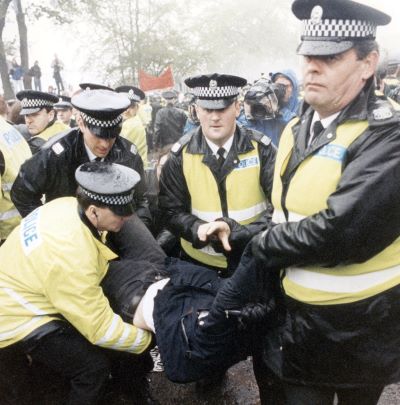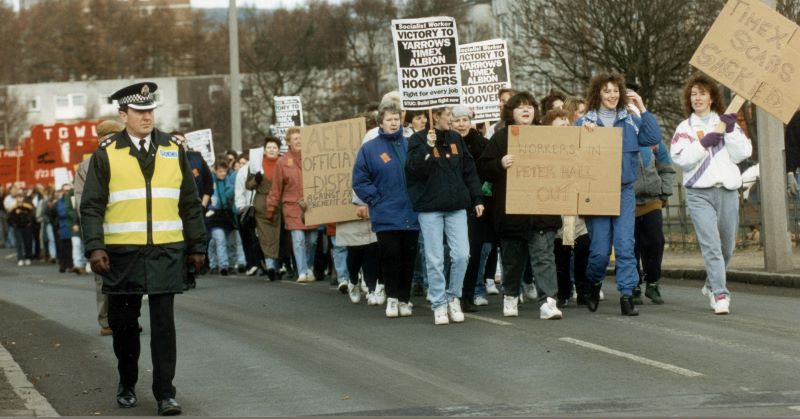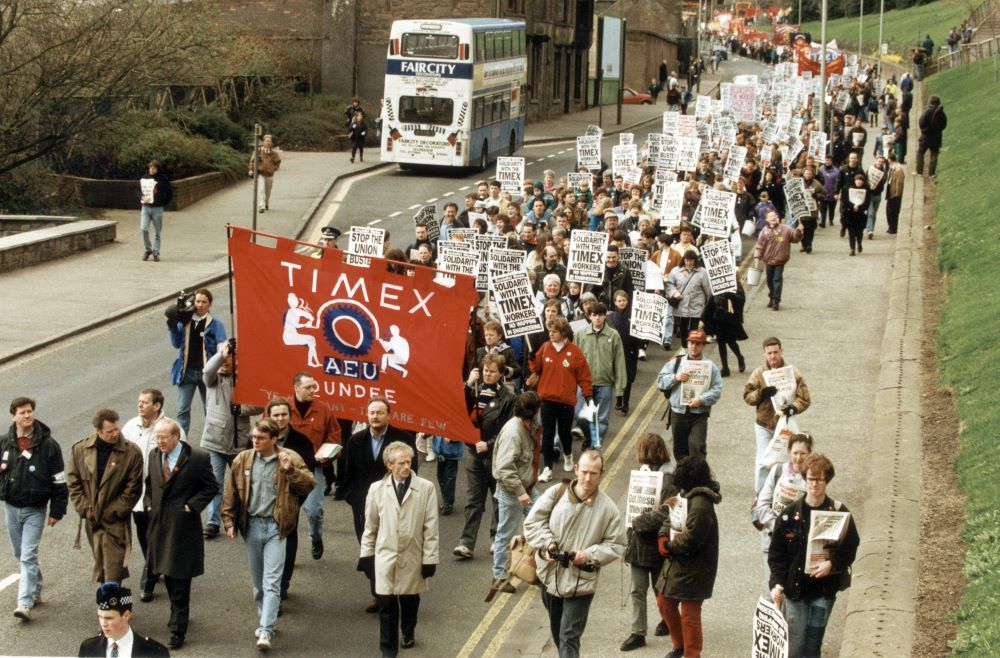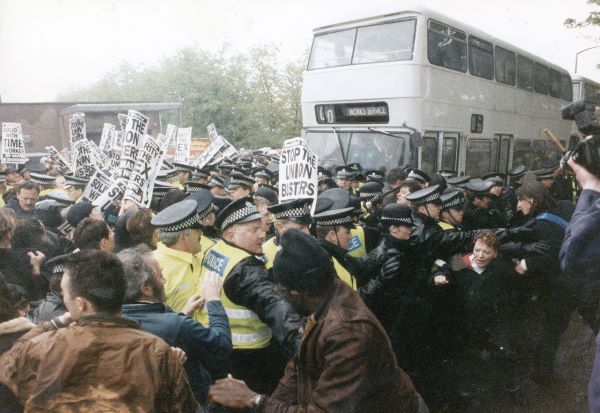Find out more about The Open University's Social Sciences courses.
This article belongs to the Women and Workplace Struggles: Scotland 1900-2022 collection.

Background
The American corporation Timex first came to Dundee in 1946, setting up with eleven workers in the back of a converted farm building. At its peak in the 1970s, Timex had become one of the largest employers in the city, employing thousands of workers at four sites across Dundee. Most of the Timex workforce were women and they performed intricate work building watches and latterly calculators, computers and cameras. Timex was keen to take advantage of an historic labour market in Dundee where the employment of women in the city’s by then declining jute industry had been a major feature of the city's labour market.
Personal stories
This article includes interviews by Stella Rooney with women who either worked for Timex or were members of the Timex Support Group at the time of the dispute in 1993.Pamela Malone worked at the Timex Dundee Harrison Road Plant for eight years. In her interview with Stella she looks back at her time there and reveals how much it meant to her.
 “I started working in
Timex in August 1977. I was 16 and just leaving school when I had the
interview. You had to also do a dexterity test. At the interview they explained
about the role and the length of training needed and you were also informed your interview was a closed shop with regard to being unionised. Within a couple
of days, I had a phone call offering me the job. I was there for eight
and a half years. The job I did was '100 put together',
so I had six weeks training and when I first started in the training
division my weekly wage was £21.50. Then after six
weeks, it went up to £47.50, so you thought you were a millionaire! Then you
moved on from the training department and were put on the assembly line. I'm still friends with some of the girls I started with more than 40 years later and we’ve got a really close friendship.
“I started working in
Timex in August 1977. I was 16 and just leaving school when I had the
interview. You had to also do a dexterity test. At the interview they explained
about the role and the length of training needed and you were also informed your interview was a closed shop with regard to being unionised. Within a couple
of days, I had a phone call offering me the job. I was there for eight
and a half years. The job I did was '100 put together',
so I had six weeks training and when I first started in the training
division my weekly wage was £21.50. Then after six
weeks, it went up to £47.50, so you thought you were a millionaire! Then you
moved on from the training department and were put on the assembly line. I'm still friends with some of the girls I started with more than 40 years later and we’ve got a really close friendship.
“Timex was such a big place, but you always knew somebody that worked there. Back in the day in Dundee, you were always guaranteed if you left school, you would definitely get a job in one of these factories. It was a bit daunting at first and the work was hard, but to this day if Timex opened again and I was sitting on the same job with the same individuals, I would go back in a heartbeat because it was such a great place to work.
“I was there for eight and half years and then unfortunately redundancy crept in, but I really enjoyed the work itself. The job was very intricate, building inside the watches with lots of components and you had your own tools. There was so much camaraderie between the women because it was a majority female workforce. The laughs we had and the nights out, you had a night out for anything basically! Someone got divorced, somebody split with their partner, and we’d have a night out on Friday.
‘It was a big loss when these factories starting closing especially for the younger generation…’
“I held out for a while, but every so often they came back with different redundancy packages. It was 1985 when I left, and I did a couple of part-time jobs but it was never the same as working in the factory environment. I missed the social aspect. I have four close friends I worked with at Timex, sadly I lost one really close pal last year. But me and all my friends from Timex still go out and socialise, my daughters have been brought up with them. It was a sad day when I walked through the Timex gates on Harrison Road for the last time.
“I think Dundee felt the loss of Timex, and of other industries deeply. There’s no industry in Dundee left now. It was a big loss when these factories started closing especially for the younger generation. When I was young if you left school and didn’t have qualifications, you knew you would be able to walk into a factory job. These days there’s nothing and I feel that is a drawback for younger people.
“Dundee women going back all these generations, we are strong individuals, and we worked our way through things. The support from your fellow women was next to none. We are strong characters.”
As Timex began to outsource labour to other parts of the world, redundancies became more common in the Dundee factories. By 1991 only one factory remained to employ 300 workers. In 1993 the final strike broke out in response to further job losses on unfavourable terms for the workers. The strike sent ripples across the city of Dundee and beyond with many members of the local community and wider trade union movement supporting the striking workers.
Mary McGregor is a retired English and Guidance teacher and lifelong political activist. During the 1993 Timex strike, she was part of the Timex Support group and continues to campaign on issues of anti-poverty and international solidarity. She spoke to Stella about her experiences of picket line solidarity and the legacy of the 1993 Timex strike.
 “Everyone in Dundee had
an association with Timex, with family and friends who worked there,
and when the dispute started the people of Dundee felt they had to be involved.
We had a template if you like, from the miners’ strike ten years previous,
where people from different political groups and none, all came together as
part of the miner’s support group.
“Everyone in Dundee had
an association with Timex, with family and friends who worked there,
and when the dispute started the people of Dundee felt they had to be involved.
We had a template if you like, from the miners’ strike ten years previous,
where people from different political groups and none, all came together as
part of the miner’s support group.
“It really was an act of class solidarity. The Timex workforce, who felt valued, who had real skills and were predominantly women, were suddenly finding themselves facing the fact that their bosses did not care about them. If they weren’t going to make a profit, then they would be discarded and cast aside. And it was that sense of injustice, and a belief that workers should have dignity that brought us together as a support group.
“We met weekly and our role was to support the strikers and the strike committee, those who were finding themselves with nothing as a result of being locked out of their workplace. We took our lead from the strike committee, and we organised socials, benefits and collected donations every week to provide sustenance for those who were no longer receiving wages. We helped to organise mass demonstrations and we helped to build awareness of the dispute throughout the city and beyond.
 Image: courtesy of Trinity Mirror/Alamy Stock Photo.“The dispute was
not simply contained within one factory or one city. When others saw the way
this transnational company was treating their workers, support groups were set
up all across the country. We provided links between those support groups, we
put people up who came to support demonstrations. But our main role was to
build awareness of what was happening in the Timex dispute across the city, the
country and internationally.
Image: courtesy of Trinity Mirror/Alamy Stock Photo.“The dispute was
not simply contained within one factory or one city. When others saw the way
this transnational company was treating their workers, support groups were set
up all across the country. We provided links between those support groups, we
put people up who came to support demonstrations. But our main role was to
build awareness of what was happening in the Timex dispute across the city, the
country and internationally.
“Women had been at the forefront of the miner’s support campaign and had been very active during anti-poll tax campaigns, so there was a tradition of women standing up and making their voices heard.
“There was no sense that the women in the support group were sidelined by louder men, we had an equal voice and if anyone tried to shut us down then that wasn’t going to happen. Women were the backbone of the Timex dispute, on the picket line and organising every day. Sometimes it was the big events that got the publicity, the mass pickets and protests, but those women were there from early morning to late at night, through the night, just making sure there was a presence on the factory gates.
“And sometimes those jobs would be overlooked. Women kept the picket tidy, and that might sound mundane, but it was important. They made sure there was food there, that people were made welcome, that there was always someone to put forward the case for the workers in dispute. Those women were always politicised in a sense, but the dispute brought something out in them as well, it was a political education for all of us. When you’re involved in a struggle it’s something that changes your mindset, and you see yourself as part of something bigger than just your specific workplace.
“These women understood that. They were women who had fought for years to provide for their families, they were strong and feisty women, and they used that strength in this dispute to show the world that they would not be treated with disrespect. They had value and they wanted everyone to know it.
“So many discussions took place on that picket line and beyond, and these women would not just be lead. These women in themselves were leaders, and they knew when they joined together they had real strength.
‘I think the strike showed that what the bosses will never understand, is the strength and solidarity that comes from class action…’
“All they ever know is the value of profit, it’s beyond their understanding that people with no vested interest would join in solidarity. The dispute won’t be remembered as a defeat, what will be remembered is the strength of those women and men. But it was a predominately women workplace, it’s something that’s important for all of us to remember as something that’s part of our culture and history.”





Rate and Review
Rate this article
Review this article
Log into OpenLearn to leave reviews and join in the conversation.
Article reviews